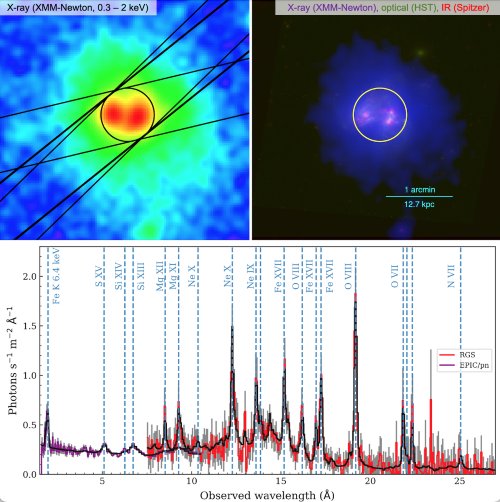Inquiries on the study
Junjie Mao
E-mail: jmao2018 * hiroshima-u.ac.jp
Graduate School of Advanced Science and Engineering, Hiroshima University
Yasushi Fukazawa
Graduate School of Advanced Science and Engineering, Hiroshima University
E-mail: fukazawa * astro.hiroshima-u.ac.jp
(Note: Please replace * with @)
Inquiries on the story
Hiroshima University Department of Public Relations
TEL: 082-424-3701
E-mail: koho * office.hiroshima-u.ac.jp
(Note: Please replace * with @

Multi-wavelength images of Arp 299 and its X-ray spectra
Upper left panel: XMM-Newton soft X-ray (0.3-2 keV) image with the RGS (rectangles) and EPIC/pn (circle) source regions. The three new observations in Cycle 19 have similar RGS roll angles so that one rectangular box appears thick. Upper right panel: A true color image of Arp 299 with soft X-ray in purple, optical (Hubble, F814W) in green, and infrared (Spitzer, 3.6 micron) in red. The bottom panel shows the XMM-Newton spectra of Arp 299. The RGS grating spectrum is shown in red, while the EPIC/pn spectrum is shown in purple. Vertical dashed lines in blue mark emission lines from various elements. Image credit: Junjie Mao
The Universe has countless stars, which come in different masses. The most common ones are the low-mass stars, including our Sun. Massive stars refer to those whose mass is more than eight times the mass of the Sun. The life of low-mass stars is quite long. For instance, our Sun can live for 10 billion years. However, massive stars can only live up to tens of millions of years. Some of these massive stars will have a splendid death. They can explode as core-collapse supernovae, which can outshine their entire galaxy. More than 2000 years ago (in the Han Dynasty), ancient Chinese astronomers kept records of the earliest supernovae observed with naked eyes by humankind.
Supernova events are rare in our galaxy due to the low star formation rate of the Milky Way. That is to say, there are not many baby stars born every year.
However, in starburst galaxies, the star formation rate can be boosted by a factor of 10 or 100! Accordingly, starburst galaxies can put on a “fireworks show” of supernovae when massive stars die. Arp 299 is a pair of colliding galaxies where numerous supernovae have exploded. In fact, it puts on at least a few “fireworks shows” of supernovae per decade.
Supernovae release not only a massive amount of photons (energy) but also a large number of elements (matter), such as oxygen, neon, magnesium, and iron. The relative amount of different elements is quite sensitive to the population of massive stars that die as core-collapse supernovae.
Using ESA’s XMM-Newton space observatory, an international group of astronomers measured the chemical composition of the X-ray emitting “confetti” in Arp 299.
It is often assumed that massive stars from 10 to 40 times the mass of the Sun can explode successfully as core-collapse supernovae. However, the observed chemical composition in Arp 299 does not match the existing theoretical models unless we remove supernovae from massive stars heavier than 23 to 27 times the mass of the Sun. This is in accordance with the fact that astronomers have not clearly observed supernovae from stars heavier than 18 times the mass of the Sun.
What happens to those massive stars, then? They might end their life as black holes with no matter escaping from it or less energetic supernovae that release a little matter. The research team also points out that it is also possible that current theoretical predictions of the elements released through core-collapse supernovae are underestimated.
About the study
Journal:The Astrophysical Journal Letters
Title: Elemental Abundances of the Hot Atmosphere of Luminous Infrared Galaxy Arp 299
Authors: Junjie Mao, Ping Zhou, Aurora Simionescu, Yuanyuan Su, Yasushi Fukazawa, Liyi Gu, Hiroki Akamatsu, Zhenlin Zhu, Jelle de Plaa, François Mernier & Jelle S. Kaastra
DOI: 10.3847/2041-8213/ac1945

 Home
Home














